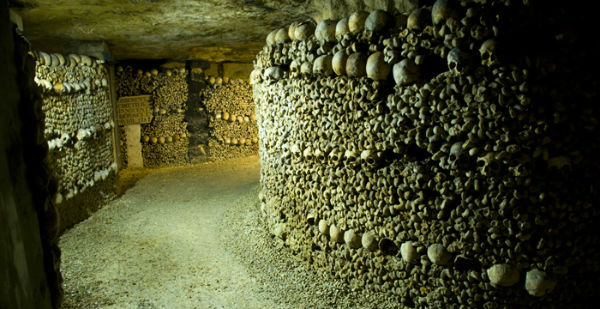The Catacombs of Paris or Catacombes de Paris is an underground ossuary in Paris, France. Located south of the former city gate (the “Barrière d’Enfer” at today’s Place Denfert-Rochereau), the ossuary holds the remains of about six million people and fills a renovated section of caverns and tunnels that are the remains of Paris’s stone mines. Opened in the late 18th century, the underground cemetery became a tourist attraction on a small scale from the early 19th century, and has been open to the public on a regular basis from 1874. Following an incident of vandalism, they were closed to the public in September 2009 and reopened 19 December of the same year.

The Catacombs are one of the 14 City of Paris’ Museums that have been incorporated since January 1, 2013 in the public institution Paris Musées.
You would have to look closely for one of its obscure entrances in the French capital of Paris.
But should you stumble upon one, it reveals an underground world of the dark, dank, narrow tunnels with a fascinating history.
Below the City of Light’s 12million residents lie the remains of 6million others – known as France’s Empire of the Dead, a world which is brought to life in a new documentary on CNN.
The Paris catacombs are a 200-mile network of old caves, tunnels and quarries – and much of it is filled with the skulls and bones of the dead.
Much of the catacombs are out of bounds to the public, making it illegal to explore unsupervised.
But nevertheless, it is a powerful draw for a hardcore group of explorers with a thirst for adventure.
A tourist-friendly, legal entrance can be found off Place Denfert-Rochereau in the 14th arrondissement of Paris, near the Montparnasse district.
Here, visitors from all over the world can descend into the city’s dark and dank bowels for a whistle-stop tour of a small section of the catacombs.
One visitor told CNN: ‘I think people are fascinated with death. They don’t know what it’s about and you see all these bones stacked up, and the people that have come before us, and it’s fascinating. We’re trying to find our past and it’s crazy and gruesome and fun all at the same time.’
The well-worn trail might be enough to satisfy the tourists, but other Parisians like to go further – and deeper – to explore the network.
The name given to the group of explorers who go into the cave network illegally and unsupervised is Cataphiles.
The top secret groups go deep underground, using hidden entrances all over the city. And they sometimes stay for days at a time, equipped with head lamps and home-made maps.
Street names are etched into the walls to help explorers navigate their way around the underground version of the city and some groups have even been known to throw parties in the tunnels or drink wine.
For catacomb devotees, the silence experienced deep in tunnels cannot be replicated anywhere else.

The number of dead bodies buried in Paris’s cemeteries and beneath its churches was so great that they began breaking through the walls of people’s cellars and causing serious health concerns.
So the human remains were transferred to the underground quarries in the early 1780s. There are now more than 6million people underground.
The space was the perfect solution to ease overcrowding in cemeteries but it presented disadvantages elsewhere.
It is the reason there are few tall buildings in Paris; large foundations cannot be built because the catacombs are directly under the city’s streets.
The tunnels also played their part in the Second World War. Parisian members of the French Resistance used the winding tunnels
And German soldiers also set up an underground bunker in the catacombs, just below the 6th arrondissement.


